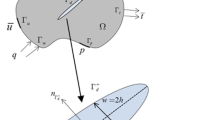Abstract
Mass transfer in a carbonate reservoir of a fractured-porous type is considered. Such reservoirs have a natural system of destruction in the form of fractures and cavities. In this paper, a mathematical model of the fluid redistribution between a porous-type matrix and a network of natural fractures is proposed and studied. The resulting system of differential equations is quasi-linear and quite complex. A number of difficulties arise in its numerical solution. First, the system contains a large number of unknown functions. Second, the nature of the nonlinearity of the equations is such that the corresponding linearized system no longer has the property of the self-adjointness of the spatial differential operators. To solve this problem, the method of splitting by physical processes and the approximation of differential operators by the finite difference method are used. The resulting split mesh model is equivalent to the discrete original balance equations of the system (conservation of mass components of fluids and total energy of the system) written in the divergent form. This approach is based on a nonlinear approximation of mesh functions in time, which depends on the fraction of the volume occupied by fluids in the pores, and is simple to implement. This paper presents the results of numerical calculations and analyzes the space-time dynamics of pressure change processes.




Similar content being viewed by others
REFERENCES
A. V. Chernitskii, The Geological Modeling of Massive Oil Fields in Carbonate Fractured Reservoirs (RMNTK Nefteotdacha, Moscow, 2002) [in Russian].
R. A. Nelson, Geologic Analysis of Naturally Fractured Reservoirs, 2nd ed. (Gulf Prof. Publ. / Butterworth-Heinemann, Boston, 2001).
T. D. van Golf-Racht, Fundamentals of Fractured Reservoir Engineering (Elsevier, Amsterdam, 1982; Nedra, Moscow, 1986).
S. O. Denk, Problems of Fractured Productive Objects (Electronic Publ., Perm, 2004) [in Russian].
J. E. Warren and P. J. Root, “The behavior of naturally fractured reservoirs,” SPE J. 3 (3), 245–255 (1963). https://doi.org/10.2118/426-PA
R. Aguilera, Naturally Fractured Reservoirs (Pennwell, Tulsa, 1980).
A. N. Tikhonov and A. A. Samarskii, Equations of Mathematical Physics (Nauka, Moscow, 1972; Dover, New York, 1990).
P. I. Rahimly, Yu. A. Poveshchenko, O. R. Rahimly, V. O. Podryga, G. I. Kasakevich, and I. V. Gasilova, “The use of splitting with respect to physical processes for modeling the dissociation of gas hydrates,” Math. Models Comput. Simul. 10 (1), 69–78 (2018). https://doi.org/10.1134/S2070048218010118
A. A. Samarskii and E. S. Nikolaev, Methods for Solving Grid Equations (Nauka, Moscow, 1978) [in Russian]; English transl.: Numerical Methods for Grid Equations (Birkhäuser, Basel, 1989).
A. A. Samarskii and A. V. Gulin, Numerical Methods (Nauka, Moscow, 1989) [in Russian].
N. N. Kalitkin, Numerical Methods (BKhV-Peterburg, St. Petersburg, 2011) [in Russian].
I. B. Petrov and A. I. Lobanov, Lectures on Computational Mathematics (INTUIT, Moscow, 2013) [in Russian].
Funding
This study was supported by the Russian Science Foundation (grant no. 21-71-20047).
Author information
Authors and Affiliations
Corresponding author
Ethics declarations
The author declares that she has no conflicts of interest.
Rights and permissions
About this article
Cite this article
Bobreneva, Y.O. Modeling the Piezoconductivity Process of a Two-Phase Fluid System in a Fractured-Porous Reservoir. Math Models Comput Simul 14, 645–653 (2022). https://doi.org/10.1134/S2070048222040032
Received:
Revised:
Accepted:
Published:
Issue Date:
DOI: https://doi.org/10.1134/S2070048222040032



